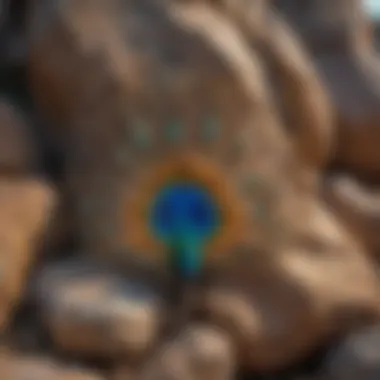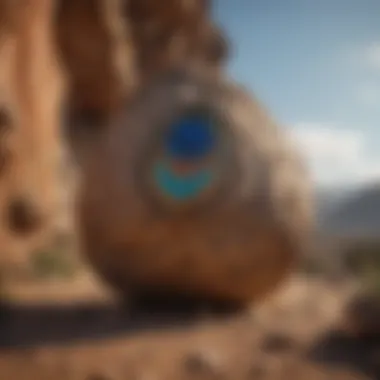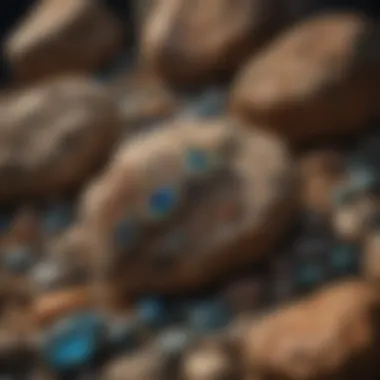Unraveling the Enigmatic Beauty of Peacock Rocks: A Geological Marvel


Rock and Fossil Identification
Peacock rocks are a unique geological formation characterized by their vibrant iridescence and intricate patterns. When it comes to identifying these mesmerizing rocks, there are key characteristics to look for. The main types of rocks that exhibit a peacock-like appearance may include chalcopyrite, bornite, and peacock ore. These rocks typically display a metallic luster with color variations that resemble the feathers of a peacock. To aid in their identification, collectors can utilize tools such as a magnifying glass or UV light to examine the markings and colors more closely. Understanding the distinct features of peacock rocks is essential for both enthusiasts and collectors.
Collecting Tips and Techniques
For avid collectors looking to add peacock rocks to their collection, employing best practices is vital. When searching for prime collecting sites, it is advisable to explore areas rich in mineral deposits where these rocks are likely to be found. Safely extracting specimens requires delicate handling to avoid damaging the intricate patterns and iridescent finish. Utilizing tools like a rock hammer and chisel can facilitate the extraction process while ensuring the integrity of the specimen. By following proper techniques and exercising caution during collection, enthusiasts can acquire stunning peacock rocks for their collections.
Preservation and Display
Following the collection of peacock rocks, it is imperative to employ effective preservation techniques to maintain their beauty and durability. These preservation methods may include cleaning the rocks gently with a soft brush and storing them in a dry, cool environment to prevent deterioration. Proper storage methods involve utilizing display cases or padded trays to prevent scratches and other damage. For creative display ideas, collectors can showcase their peacock rocks in illuminated displays or shadow boxes to highlight their iridescent qualities and intricate details, enhancing their aesthetic appeal.
Geological Insights
Delving into the geological significance of peacock rocks unveils a fascinating world of natural processes and historical relevance. The formation of these rocks is attributed to mineral crystallization in specific geological conditions, resulting in their unique iridescence. Exploring the historical significance of peacock rocks reveals their role in ancient cultures where they were prized for their beauty and perceived mystical properties. Notable discoveries in the field of geology have shed light on the origin and composition of these rocks, contributing to our understanding of the earth's geological evolution.
Introduction
What are Peacock Rocks?
Definition and Overview
Peacock rocks, with their mesmerizing iridescence, are a captivating geological wonder that continues to fascinate both enthusiasts and scholars. The term 'Peacock Rocks' refers to a distinct type of rock formation characterized by its vivid colors and unique composition, resembling the vibrant hues of a peacock's plumage. This section will delve into the specific features that define Peacock Rocks, showcasing their allure and significance within the realm of geology.
Unique Geological Composition
The unique geological composition of Peacock Rocks sets them apart from traditional rock formations. These rocks boast a complex structure comprised of minerals such as chalcopyrite, bornite, and covellite, which contribute to their striking color variations. Their formation process involves intricate mineral crystallization within specific environmental conditions, resulting in the characteristic iridescence that captivates collectors. Understanding the geological composition of Peacock Rocks is essential for comprehending their beauty and geological importance.
Historical Significance
Origins and Discovery
The origins and discovery of Peacock Rocks hold significant historical and scientific value. Dating back to ancient times, these rocks were initially uncovered by explorers who marveled at their radiant colors and unique properties. The discovery of Peacock Rocks revolutionized geological studies by providing insights into mineral formations and crystal growth mechanisms. Exploring the origins of these rocks opens doors to understanding the Earth's geological history and the intricate processes that shape our planet.
Impact on Geological Studies
The impact of Peacock Rocks on geological studies cannot be overstated. Their distinctive characteristics offer valuable clues about environmental conditions and geological processes that have shaped our planet over millions of years. By examining Peacock Rocks, geologists can decipher past climatic changes, sedimentary patterns, and mineral formations, contributing to a deeper understanding of the Earth's evolution. Peacock Rocks serve as invaluable tools for geologists seeking to unravel the mysteries of our planet's past.
Formation Process


Peacock rocks allure collectors and geology enthusiasts with their mesmerizing beauty and intriguing formation process. Understanding the formation process is crucial to unraveling the mysteries behind these geological wonders. In this article, we delve deep into the intricate mechanisms that give rise to peacock rocks, shedding light on the specific elements that contribute to their unique characteristics and visual appeal. By exploring the formation process, readers can gain a comprehensive insight into the geological forces at play, highlighting the significance of this topic in unveiling the mystique of peacock rocks.
Geological Factors
Mineral Composition:
Peacock rocks owe their stunning colors and patterns to the intricate mineral composition embedded within their structure. The specific aspect of mineral composition plays a pivotal role in defining the overall aesthetic appeal of these rocks. Their mineral composition, characterized by a harmonious blend of vibrant pigments, contributes to the captivating allure that fascinates collectors and geologists alike. The unique feature of mineral composition lies in its ability to create iridescent displays, making it a particularly favored choice for showcasing nature's artistic prowess within this article.
Environmental Conditions:
The environmental conditions in which peacock rocks form also play a significant role in shaping their mesmerizing appearance. These conditions dictate the availability of minerals, temperature variations, and other factors that influence the crystal growth and coloration of the rocks. Highlighting the key characteristic of environmental conditions sheds light on why they are a crucial element in the formation of peacock rocks. Despite potential drawbacks, these environmental conditions provide a conducive setting for the development of the vibrant hues and intricate structures that define these geological marvels.
Crystal Growth Mechanism
Internal Dynamics:
The internal dynamics of peacock rock formation involve intricate processes that guide the growth and arrangement of crystals within the rock matrix. Understanding the key characteristic of internal dynamics offers insights into the dynamic interplay of forces that lead to the unique patterns and textures seen in peacock rocks. This aspect serves as a valuable lens through which to explore the inner workings of these geological formations, showcasing their complexity and natural artistry.
External Influences:
External influences, such as geological forces and environmental factors, also impact the crystal growth mechanism of peacock rocks. These influences shape the external appearance and structural integrity of the rocks, molding them into visually striking displays of natural magnificence. By delving into the unique features of external influences, we can appreciate how external factors interact with internal dynamics to produce the exquisite beauty that distinguishes peacock rocks within this article.
Characteristics of Peacock Rocks
Delving into the captivating world of peacock rocks reveals a myriad of distinctive features that make them a fascinating geological wonder. These characteristics play a vital role in not only enhancing the aesthetic appeal of peacock rocks but also in providing valuable insights into geological processes. Understanding the features of peacock rocks is essential for rock and fossil collectors as it allows them to appreciate the uniqueness of these formations and aids in specimen identification and classification. Moreover, the characteristics of peacock rocks serve as indicators of the environmental conditions and mineral compositions that contributed to their formation, making them invaluable specimens for geological studies.
Colorful Displays
Iridescence
Iridescence, a mesmerizing optical phenomenon exhibited by peacock rocks, adds a captivating allure to these geological treasures. The iridescent quality of peacock rocks manifests as a play of vibrant colors that shimmer and shift when viewed from different angles, enchanting collectors and enthusiasts alike. This iridescent effect arises from the diffraction of light on the microstructures within the rock, giving rise to the spectacular display of colors that define peacock rocks. The unique feature of iridescence not only enhances the visual appeal of peacock rocks but also makes them highly sought after for their aesthetic charm and beauty. However, while iridescence adds to the allure of peacock rocks, it can also pose challenges in capturing their true essence accurately in photographs or digital representations.
Color Variations
The diverse color variations found in peacock rocks further contribute to their mesmerizing beauty and appeal. Ranging from vibrant blues and greens to subtle purples and pinks, the color variations in peacock rocks showcase the diverse mineral compositions and environmental influences that dictated their formation. These color variations not only make each peacock rock unique but also provide valuable clues about the geological processes that shaped them. Collectors and researchers find the study of color variations in peacock rocks intriguing as it offers insights into the conditions under which the rocks crystallized, emphasizing their significance in geological studies and specimen analysis.
Structural Features
Layering Patterns


The intricate layering patterns observed in peacock rocks add a layer of complexity to their overall structure and appearance. These layering patterns, often resembling delicate brushstrokes of nature, indicate the sequential deposition of minerals and sediments over time. Studying these layering patterns provides essential information about the conditions prevailing during the formation of peacock rocks, helping geologists reconstruct past geological events and environmental changes. Moreover, the unique layering patterns contribute to the aesthetic appeal of peacock rocks, making them highly prized for both their visual allure and scientific value.
Surface Textures
The surface textures of peacock rocks play a crucial role in defining their tactile and visual properties. From smooth, glass-like surfaces to rough, textured exteriors, the varying surface textures of peacock rocks add depth and tactile interest to these geological wonders. Collectors appreciate the diverse surface textures of peacock rocks as they not only enhance the overall aesthetic appeal of the specimens but also provide valuable information about the conditions under which the rocks were formed. Examining the surface textures of peacock rocks under different lighting conditions reveals hidden details and intricacies, highlighting the meticulous craftsmanship of nature in creating these mesmerizing formations.
Significance in Geology
Peacock rocks hold significant importance in the field of geology, serving as a unique window into past environmental conditions and geological processes. Understanding the formation and composition of these rocks provides valuable insights into the earth's history and the changes it has undergone over time. Geologists and researchers study peacock rocks to unravel the mysteries of environmental evolution and geological phenomena.
The allure of peacock rocks extends beyond their aesthetic appeal; they offer tangible evidence of natural processes that have shaped the planet. By examining the mineral composition and structural characteristics of these rocks, geologists can trace back environmental changes and interpret the geological events that have influenced their formation. Peacock rocks stand as testament to the intricate connections between geological processes and environmental shifts, making them invaluable assets for geological studies.
Geological Applications
Evidence of Environmental Changes
Peacock rocks serve as valuable indicators of environmental changes throughout history, with their vibrant colors and layered structures preserving a chronicle of past conditions. The iridescence and color variations observed in peacock rocks reflect shifts in environmental elements such as temperature, pressure, and mineral deposition. Geologists utilize these rocks as visual records that capture the dynamic nature of the earth's environment over time.
The unique feature of peacock rocks lies in their ability to encapsulate a snapshot of environmental conditions within their crystalline structures. Each layer in these rocks represents a distinct period in geological history, allowing researchers to reconstruct past climates and atmospheric compositions. The presence of specific minerals and crystal formations further aids in identifying environmental trends, making peacock rocks a valuable resource for understanding long-term environmental changes.
Indicator of Geological Processes
Peacock rocks act as indicators of geological processes, showcasing the interplay between internal dynamics and external influences that shape rock formations. The layering patterns and surface textures found in these rocks reveal the intricate mechanisms of crystal growth and geologic activity. Geologists study these features to decipher the forces at play during the formation of peacock rocks, gaining insights into the geological processes that have sculpted the earth's surface.
The key characteristic of peacock rocks as indicators of geological processes lies in their ability to showcase the transformative effects of environmental factors on rock formation. By examining the mineral composition and crystal growth mechanisms of these rocks, geologists can discern the interactions between geological processes and external conditions. Peacock rocks offer a unique perspective on the complex interplay of forces that have shaped the earth over millennia, making them indispensable tools for studying geological phenomena.
Collecting and Preserving Peacock Rocks
In this section of the article, we delve into the crucial aspect of Collecting and Preserving Peacock Rocks, shedding light on its significance for enthusiasts and collectors dedicated to uncovering the mystique of these geological marvels. The process of collecting and preserving peacock rocks is not merely a hobby but a meticulous undertaking that requires attention to detail and proper preservation techniques to maintain the integrity and beauty of these iridescent wonders.
Collecting and preserving peacock rocks is an integral part of the fascination surrounding them, as enthusiasts seek to create curated collections that showcase the diversity and beauty of these geological formations. By understanding the importance of proper handling and storage, collectors can ensure that peacock rocks retain their vibrant colors and structural integrity for years to come, enjoying their captivating allure for generations.
Best Practices
Within the realm of collecting and preserving peacock rocks, adherence to best practices is paramount to maintain the quality and value of these geological treasures. Let's explore two key aspects in detail:
Handling Techniques
Handling techniques play a crucial role in the preservation of peacock rocks, as the delicate nature of these formations requires gentle and precise manipulation to prevent damage or deterioration. Enthusiasts are advised to use specialized tools such as soft brushes and protective gloves to minimize direct contact and avoid unnecessary stress on the rocks' surfaces.


The key characteristic of effective handling techniques lies in their ability to safeguard the intricate layering and iridescent sheen of peacock rocks, ensuring that collectors can admire them in their full glory. By employing careful handling practices, enthusiasts can prolong the lifespan of these geological wonders and maintain their aesthetic appeal.
Storage Recommendations
Equally important are proper storage recommendations, which provide a controlled environment for peacock rocks to prevent discoloration, breakage, or exposure to harmful elements. It is recommended to store peacock rocks in a dry, cool space away from direct sunlight and moisture, as these factors can compromise the integrity of the specimens over time.
The unique feature of ideal storage conditions is their ability to create a stable environment that safeguards the iridescence and structural features of peacock rocks, preserving their allure for future observation and appreciation. Through strategic storage recommendations, collectors can safeguard their prized specimens and continue to marvel at the geological wonders found within peacock rocks.
Exploring Peacock Rocks Online
Exploring Peacock Rocks Online opens up a realm of possibilities in understanding and appreciating this geological marvel from the comfort of your own screen. In this digital age, the significance of virtual exploration cannot be overstated. By delving into online platforms dedicated to peacock rocks, enthusiasts and collectors can gain valuable insights, connect with like-minded individuals, and enhance their knowledge about these enchanting formations.
Virtual Collections
Websites and Online Resources
Websites and Online Resources play a pivotal role in offering a wealth of information on peacock rocks. These platforms serve as virtual repositories of knowledge, showcasing intricate details about the formation, characteristics, and significance of these unique geological wonders. The key characteristic of Websites and Online Resources lies in their accessibility and convenience. Enthusiasts can access a plethora of data, images, and educational material with just a few clicks, making it a convenient and beneficial choice for those eager to expand their understanding of peacock rocks. One unique feature of these online resources is the ability to interact with experts, share experiences, and participate in online discussions, enriching the overall learning experience. While the advantages include easy access to information and community engagement, disadvantages may revolve around the credibility and accuracy of content, requiring users to discern the reliability of sources.
Digital Exhibitions
Digital Exhibitions offer a visually immersive experience, bringing the beauty of peacock rocks directly to your screen. Through high-resolution images, videos, and interactive displays, these exhibitions provide a dynamic platform for showcasing the vibrant colors and intricate patterns of peacock rocks. The key characteristic of Digital Exhibitions is their ability to evoke a sense of wonder and awe, captivating audiences with detailed visuals and engaging presentations. This immersive approach makes Digital Exhibitions a popular choice for enthusiasts seeking a virtual tour of peacock rocks. A unique feature of these exhibitions is the incorporation of multimedia elements, such as 3D models and virtual reality simulations, enhancing the viewer's experience. While the advantages include visual appeal and accessibility, potential disadvantages may relate to the limitations of virtual representation compared to physical observation.
Community Engagement
Forums and Discussion Platforms
Forums and Discussion Platforms serve as dynamic spaces for engaging with a community of peacock rock enthusiasts. These online forums allow individuals to share their findings, ask questions, and participate in discussions related to peacock rocks. The key characteristic of Forums and Discussion Platforms is the opportunity for knowledge exchange and networking. Enthusiasts can interact with experts, seek advice, and engage in meaningful dialogues, making it a beneficial choice for those looking to broaden their understanding of peacock rocks. A unique feature of these platforms is the sense of community built around a shared passion for geological wonders, fostering collaboration and camaraderie among members. While the advantages include shared learning and networking opportunities, potential disadvantages may involve moderation issues and conflicting information that require careful navigation.
Collaborative Projects
Collaborative Projects entail joint endeavors aimed at advancing the study and preservation of peacock rocks. By joining forces with peers, enthusiasts can undertake research, conservation efforts, or educational initiatives that contribute to the collective understanding of these geological formations. The key characteristic of Collaborative Projects is the synergy generated through combined expertise and resources. Working together allows participants to tackle complex challenges, conduct in-depth analyses, and produce valuable outcomes, making it a popular choice for those passionate about making a tangible impact. A unique feature of collaborative projects is the sense of accomplishment and satisfaction derived from shared achievements, driving motivation and fostering a sense of community. While the advantages include collaborative learning and meaningful contributions, potential disadvantages may involve coordination challenges and differing priorities that require effective communication and coordination.
Conclusion
Delving into the captivating world of peacock rocks unveils a geological wonder that not only mesmerizes with its iridescent beauty but also offers profound insights into Earth's intricate processes. Throughout this article, the significance of peacock rocks in geology has been underscored, highlighting their unique formation, characteristics, and geological relevance. By exploring the formation processes, characteristics, and significance of these rocks, we gain a deeper appreciation for the intricate wonders nature presents. The study of peacock rocks offers invaluable knowledge about environmental changes and geological processes, making them invaluable natural artifacts deserving of study and admiration. Peacock rocks serve as enticing gateways into the mesmerizing world of geological wonders, inviting enthusiasts and collectors to delve deeper into Earth's mesmerizing artistry.
Appreciating Nature's Artistry
Peacock Rocks as Natural Masterpieces
Peacock rocks stand out as natural masterpieces due to their stunning iridescence, vibrant colors, and unique structural features. These geological marvels captivate the eye with their kaleidoscopic displays, showcasing nature's artistry in every layer and texture. Their iridescent hues reflect intricate mineral compositions and crystalline structures, setting them apart as timeless creations that exemplify the beauty of Earth's geological formations. As key features in this article, exploring peacock rocks as natural masterpieces sheds light on their incomparable beauty and geological significance, urging us to appreciate the intricate wonders nature presents. The unique color variations and layering patterns of peacock rocks as natural masterpieces offer collectors and enthusiasts a visually striking and scientifically intriguing subject of study, epitomizing the harmonious blend of aesthetic appeal and geological importance.
Continued Fascination in Geological Wonders
Continued fascination in geological wonders stems from the endless mysteries and revelations they offer about Earth's history and evolution. Peacock rocks symbolize a perennial allure in the realm of geological marvels, piquing curiosity and inviting exploration into the depths of our planet's intricate formations. Their enduring charm lies in the tangible connections they provide to ancient geological processes, serving as tangible testaments to Earth's ever-evolving landscapes and environmental changes. Within the context of this article, embodying the awe-inspiring spirit of geological wonders drives a relentless pursuit of knowledge and appreciation for the natural world. The continued fascination in geological wonders, exemplified by peacock rocks, serves as a poignant reminder of the vast depths of Earth's secrets waiting to be unveiled, fostering a sense of wonder and curiosity that transcends time and space.







